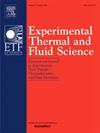Investigation on aerodynamic force behavior and flow structure of Ahmed body under crosswind
IF 3.3
2区 工程技术
Q2 ENGINEERING, MECHANICAL
Experimental Thermal and Fluid Science
Pub Date : 2025-03-29
DOI:10.1016/j.expthermflusci.2025.111488
引用次数: 0
Abstract
This study investigates the aerodynamic performance and the near wake of the Ahmed body under crosswind conditions experimentally at a length-based Reynolds number [0.11, 0.64] × 106. The slant angle of the Ahmed body is 35°, and the yaw angle (β) ranges from 0° to 30°. Throughout the investigations, force, pressure, particle image velocimetry (PIV) and flow visualization measurements are conducted. The variation of drag coefficient with yaw angle follows a parabolic curve, with a remarkable increase in occurring at 6°<β < 16° yaw angle. Non-uniformity and asymmetry in pressure distribution are shown on the base and slant surfaces, which can be attributed to the asymmetry behavior of recirculation structures behind the body. As the yaw angle increases, the shrinking of recirculation structures and the movement of their foci toward the surface contribute to a significant reduction in pressure on the leeward side of rear surface, thereby increasing drag. The shear layer on the windward side is suppressed, while on the leeward side, it separates prematurely, corresponding to an increase in the side force. Based on the findings of the present study and previous literature, a conceptual model of the flow structure is proposed for the 35° slant angle Ahmed body under crosswind, aiming to explain the evolution of the behavior of forces, pressure distribution, and the flow structures.
侧风作用下艾哈迈德体气动力特性及流动结构研究
本文在基于长度的雷诺数Rel∈[0.11,0.64]× 106条件下,对侧风条件下艾哈迈德体的气动性能和近尾迹进行了实验研究。艾哈迈德体的倾斜角为35°,偏航角(β)范围为0°至30°。在整个研究过程中,进行了力、压力、颗粒图像测速(PIV)和流动可视化测量。阻力系数Cd随偏航角的变化呈抛物线曲线,在6°<;β <;16°偏航角。基面和斜面压力分布的不均匀性和不对称性可归因于阀体后方再循环结构的不对称性。随着偏航角的增大,再循环结构的收缩及其焦点向表面移动,使得后表面背风侧压力显著降低,从而增加阻力。迎风面剪切层受到抑制,而背风面剪切层过早分离,对应侧力增大。在本研究成果的基础上,结合已有文献,提出了侧风作用下35°斜角艾哈迈德体流动结构的概念模型,旨在解释力、压力分布和流动结构的演变。
本文章由计算机程序翻译,如有差异,请以英文原文为准。
求助全文
约1分钟内获得全文
求助全文
来源期刊

Experimental Thermal and Fluid Science
工程技术-工程:机械
CiteScore
6.70
自引率
3.10%
发文量
159
审稿时长
34 days
期刊介绍:
Experimental Thermal and Fluid Science provides a forum for research emphasizing experimental work that enhances fundamental understanding of heat transfer, thermodynamics, and fluid mechanics. In addition to the principal areas of research, the journal covers research results in related fields, including combined heat and mass transfer, flows with phase transition, micro- and nano-scale systems, multiphase flow, combustion, radiative transfer, porous media, cryogenics, turbulence, and novel experimental techniques.
 求助内容:
求助内容: 应助结果提醒方式:
应助结果提醒方式:


